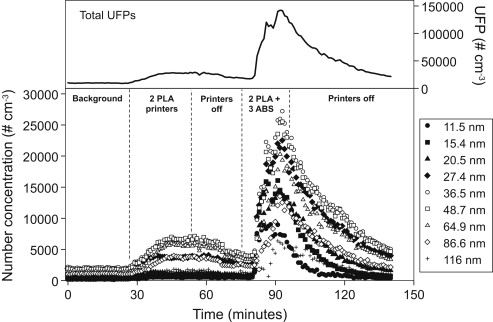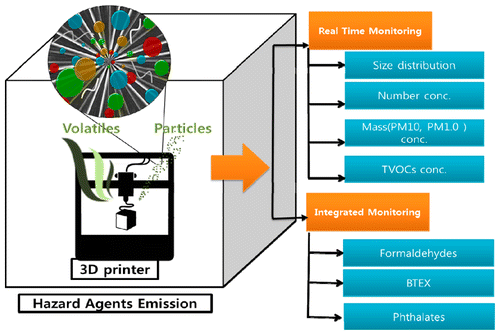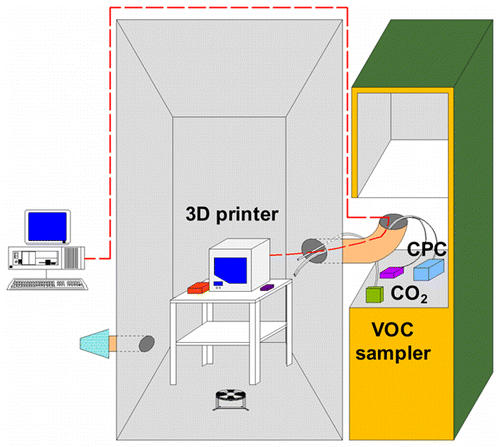My father was a professional printer. As a small boy, he sometimes took me to his shop for a visit and I can still remember the large, gray machines, the smell of chemicals and paper, and the noise! Now, some 30 years, a whole lot of education, and three different careers later, I find myself a printer also. And while the irony is not lost on me, the printing I do is markedly different than the offset process my father was so skilled at. But one thing that is worryingly similar is the potential health hazards we face using these machines, and there are several new studies beginning to look at what those risks may be.

Occupational diseases and injuries have been known about since the Italian physician Bernardino Ramazzini first wrote about the subject back in 1700. And, though we now all know about these types of disorders, we still sometimes get surprised by them – think Carpal Tunnel Syndrome of the late 80’s and early 90’s. But what does this have to do with our 3D printers?
The trouble with 3D printers is that these machines were originally developed for industrial purposes, and work in that environment very well. Industry has long experience using, working with, and protecting their employees from toxic substances, but the general public does not. Since these machine were fairly simple, they were relatively easy to scale down and adapt to home use, even though they still use what is basically industrial-grade feedstocks for their operation. And while the dangers of being burned by a hot extruder, or heated buildplate are obvious, the potential risks from the fumes and vapors produced by the printers may not be.
When I was still researching this article, I spoke to a good number of people, and some expressed their anxiety that an open discussion of this topic, since there was no definitive proof of any health-related problems, may hurt the development and growth of the technology. This is a valid concern, and one I fully understand. So, before we begin, we need to firmly establish that, though some readers may find the information in this article alarming, none of the experts I spoke to, nor any of the documentation I reviewed, has shown a conclusive link between the use of a 3D printer and any known health risks. That being said, it is my opinion that it is always preferable to be ahead of a problem, rather than trying to scramble to find a fix once the damage has been done.
While I understand that issues like this are about as popular as the proverbial turd in the punch bowl, we have a responsibility to make sure that we create an industry and community that is safe, productive, and beneficial to society at large. 3D printing and other forms of additive manufacturing have the potential to be the most socially transformative technology since the invention of the printing press itself, but it cannot and will not progress as quickly as it should if people and societies put up barriers to it due to fears that the technology will harm them, their loved ones, or their companies. It is immaterial whether or not those fears are grounded in fact or are merely the products of imagination…the effects will be very real. So, let’s begin by clearing the air.
—————————————————————————————————–
For many people, the issues of indoor air quality started with the second hand smoke debate that really got going in the 1990s. Passive smoking generated a lot of controversy, but in the end, the overwhelming scientific evidence generated by hundreds of studies silenced opponents and new laws and regulations were established. Things looked like they were quieting down, when, in 2007, there was a minor dust-up over something called “nanoparticles” (also called “Ultrafine Particles” or “UFPs” for short) being emitted from office 2D laser printers.
A research paper from the Queensland Institute of Technology in Australia, which was subsequently profiled in Time Magazine, found that offices where laser printers were used had concentrations of particulate matter 5 times higher during working hours (when the printers were in use) than during non-working hours. Being one of the industry leaders, and being specifically called out as the maker of some of the “dirtiest” printers tested, the study caught Hewlett-Packard by surprise. A very ugly public relations battle ensued for a brief time, until corrective actions were taken, and the issue vanished almost as quickly as it had appeared.
This issue then arose to our community in 2013, when we saw the very first scientific article that linked the operation of a 3D printer with indoor air quality. In a study titled, “Ultrafine particle emissions from desktop 3D printers” from the Illinois Institute of Technology, a positive, although somewhat tentative, connection between 3D printers and UFP pollution was shown. Dr. Brent Stephens, author of the report, explained that the paper originated almost by accident and was done out of mere scientific curiosity. “I was teaching an indoor air class in environmental engineering,” Dr. Stephens said, “and near the end of the semester one of my students had taken a job at a local 3D print shop here in Chicago and he asked me about it, as he said it smelled funny.”

Before Dr. Stephens and his team began, they noted that there were previous studies available that had looked at the thermal processing of plastics which showed both gases and particles were emitted during the operation of industrial machines. There were also studies that showed ABS produces gas-phase products including carbon monoxide and hydrogen cyanide. While this showed that some dangers were known, they couldn’t find any studies done on desktop 3D printers. They secured access to a 45-cubic-meter room in a local business in Chicago where 3D printing was taught and set up what he called an “ad hoc” style experiment just to see what concentration of UFPs, if any, these new 3D printers produced. They only tested machines working with PLA and ABS, but their findings were surprising.
Importantly to us, they found that, when the five available printers were all operating, 2 of which used PLA and 3 which used ABS, the peak total amount of UFPs in the room rose as high as 15 times the level you would find when the printers were not operating. The results also showed that the amount and size of the particles released depended greatly on a number of different factors, most notably the temperature the printers were operating at. He went on to say that the resulting article got far more attention than he had initially anticipated, and that it became very clear that follow-up studies needed to be done.
It took nearly two years before the next important paper on the topic came out, when researchers at Seoul National University in South Korea released “Emissions of Nanoparticles and Gaseous Material from 3D Printer Operation” in September of 2015. Korea has been playing a bit of “catch up” with other nations when it comes to 3D printing, but, recently, the Korean government has been pushing the 3D technology development and education pretty hard, and some questions arose.

According to Dr. Chungsik Yoon, one of the study’s authors, the research project arose in relation to the Korean government’s plan to establish “genius rooms” in the elementary schools where 3D printing and robotics would be taught. The indoor air quality of those spaces was a major concern, and many teachers had expressed their anxieties to the government, who in turn wanted some answers. As he said, “This area of investigation is just beginning, so there isn’t much data out there yet. We are trying to expand our research to cover other issues, for it is most important to know the real situations in the (printing) rooms.”
In their study, the Korean researchers tested PLA and ABS filaments in two different FDM-style desktop printers in a one-meter-square test chamber and measured the amounts of not just the particulate (UFPs) matter, but also the gaseous volatile organic compounds (VOCs) emitted before, during, and after the printing process. The researchers used a “clean” chamber to conduct the test, meaning that all UFPs and VOCs that may be present in normal outdoor air were removed prior to the tests beginning. This was important so that any non-printer generated particles or vapors would not interfere with the measurements of the machines’ operation.
In a nutshell, they found that all filaments produced significant UFP air pollution, with ABS being the worst offender. According to their measurements, ABS-producing particle counts some 345 times higher during the printing process than before the process started. And while PLA did better, it produced counts that were 21 to 26 times higher during the printing process than before it started. The study did note that particle counts dropped off fairly quickly after the printing process finished.
The VOC counts were likewise illuminating, in that several different chemicals were specifically tested for including; ethylbenzene (styrene), m- and p-xylene, formaldehyde, acetaldehyde, isovaleraldehyde, diethyl phthalate (DEP), dibutyl phthalate (DBP), and Bis (2-ethylhexyl) phthalate (DEHP), all of which have some fairly worrying traits, and which can be researched online by those so interested. Save to say, the less exposure to these chemicals you have, the better off you are.
According to the measurements taken, ABS released the most vapors, recording ethylbenzene levels at 16.4 times higher than outdoor air concentrations, isovaleraldehyde at 11.9 times higher, acetaldehyde at 3.2 times higher, and low, but detectable, levels of DEP, DBP, and DEHP. The PLA samples tested, while far less dirty than the ABS, didn’t exactly come away completely clean, recording levels of formaldehyde at 5.2 times higher than outside air concentrations, along with low, but detectable, levels of DEP, DBP, and DEHP.
When asked about these results, specifically regarding PLA, Dr. Yoon opined that the results could be due to several different factors, such as chemical additives mixed with the base material, as well as printer temperature setting. Thermal degradation of polymers can occur when the extruder temps are too high, and of course, higher temperatures will release more fumes as it is easier for volatile compounds to escape into the air as the plastic becomes less and less solid. “For now, obviously PLA is better than ABS,” he said, “and an enclosed printer with a filter is better than an open printer without one, but (filament) manufacturers need to monitor the chemical additives they use in their filament formulations very carefully, and (hardware makers) should strive to design enclosed machines with improved filtration systems.”
Dr. Yoon was careful to point out that his team’s intent was to test the machines for UFP and VOC emissions, and not to test for user exposure, which is a very different matter. As such, the readings used in the report were taken from a sensor array situated directly above the printheads. Due to the heat of the printhead and the placement of the sensors, the readings were as precise as could be expected, and may be much higher than what an operator would be exposed to. The study was done in this way so that the results could easily be replicated and compared to other similarly conducted tests.
Dr. Yoon also noted that, as far as he knew, there currently was no standard method for testing filaments or 3D printers. He said he will be expanding his research, and thinks it is important to have an easy way to test and compare filaments and machines. He also plans to continue to study the ways that, and the conditions under which, people are actually using these machines so that safe practices and governmental guidelines can be developed to protect the public, especially in the educational sector.
The third, and most recent study to come out was just released earlier last month. This one, called “Emissions of Ultrafine Particles and Volatile Organic Compounds from Commercially Available Desktop Three-Dimensional Printers with Multiple Filaments” was a follow up study by the same team who did the very first study way back in 2013. This time, their testing process was carried out in a carefully constructed test chamber and they used a variety of filaments (not just ABS and PLA) and printers to see if, and how, the various combinations influenced each other.

What they found was that 3D printer emissions (both UFPs and VOCs) were related to a number of expected factors, such as filament composition and nozzle temperature, but also from some rather unexpected ones, such as model of the printer, the shape of the printed object being built, the time of the build, and the buildplate temperature. Dr. Brent Stephens, the study’s lead author, found that curious, and said there will need to be a closer examination of these factors in the future. “The heated bed can be a source of particle generation, possibly due to ambient settling, but we are not sure.”
The Chicago researchers found that all printers and filament combinations released both VOCs and UFPs, albeit in different levels, amounts, and kinds. As might be expected by now, the highest UFP emissions came from printers using ABS and the lowest from 3 different printers using PLA. Likewise, VOC emission types varied mostly depending upon what the filament was made of, while printer make and model drove the differences in the overall mass of VOC emissions when using the same filament. Also of interest is the fact that only 3 chemicals made up over 70% of all VOC emissions; namely styrene from ABS and HIPS, caprolactum from Nylon, PCTPE, Laybrick and Laywood, and lactide from PLA.
Dr. Stephens cautioned that the results found need to be understood properly, as the findings are measurements of concentration amounts, and not exposure amounts. Like Dr. Yoon before him, Dr. Stephens also noted that, while good for hardware testing and comparisons, “Concentration measurements are not really helpful for determining the dangers posed to operators as the concentrations depends on a lot of factors, not the least of which is room size. UL did some gas-phase testing around 2014, but they have not published their findings. Future studies should include a look at concentration levels in exposure zones, as well as which types of ventilation and filtration methods are best suited to the technology.”
————————————————————————————————-
So, what is all this fuss about anyway? Does this mean that when I try to print a small plastic frog at home, I am going to gasp for breath and fall over dead? No, of course not – and that is a big part of the problem, because, if 3D printing was even half that risky, we would all be acutely aware of the dangers and no one would even think to question the need for safety protocols. But here, there have been no known injuries or illnesses, so it is quite easy to not think about the potential risks we are subjecting ourselves to. Some fellow makers I spoke to while writing this article were somewhat cavalier about it. There is even one giant toy company out there that is about to launch a printer aimed exclusively at children, which presumably would end up in many kids’ bedrooms. So, let’s just take a few minutes and explore why we should care about this issue.
First, the trouble breaks down in two major ways: mechanical injury from the inhalation of nanoparticles (the UFPs or “ultrafine particles”), and exposure poisoning from the chemicals present in and/or released from the polymers, particularly the “volatile organic compounds” (VOCs). In addition, we must distinguish between what are called “acute effects” and “chronic effects”. Acute effects are those events that are severe and sudden, such as respiratory distress, or more severely, cardiac arrest. A chronic effect on the other hand, is a long-developing syndrome, such as asthma or chronic obstructive pulmonary disease (COPD) which can take years to develop.
Let’s start with the particulates. Nanoparticle and Ultrafine Particle are the interchangeable generic terms for any solid particle that is less than 100 nanometers in size. UFPs can present several different kinds of dangers due to not only their composition, which may or may not be toxic, but also their size. When inhaled, they can become trapped in the very smallest areas of the lung’s alveoli, which are the tiny sacs covered in blood capillaries where oxygen and carbon dioxide are exchanged between the blood stream and the lungs. More worryingly, if they are small enough, the particles can actually pass directly from the lungs into the blood stream, and, once there, move on to, and accumulate in, other organs in the body such as the brain, the liver, or spleen.
And the particles do not have to be toxic in and of themselves to cause systemic problems or poisoning, so even PLA particles (which currently are widely believed to be non-toxic) can fill the lungs with materials that could prevent them from being able to function correctly. While researchers are just beginning to look at the potential health issues related to UFPs, there was at least one environmental study that claims to have found a direct link between nanoparticle air pollution and elevated systolic blood pressure in school children.
And, as bad as that may be, particles this small have a very high surface area to volume ratio which can make them highly reactive or even catalytic. What that means in practical terms is that, due to the particles’ small size, there are a greater portion of atoms at or near the surface of the particle than buried deep inside it, meaning that there is a greater number of atoms that can bond to, or react with, chemicals in the environment than would be able to in particles of larger sizes. This tendency to be highly reactive is one of the key features that makes nano technology so exciting and efficient, but, in our bodies, that benefit can become a serious problem.
On the other hand, “volatile organic chemicals,” or VOCs for short, is a term that is used to describe the chemical gaseous vapors released during the printing process. The group can include any number of different chemicals, and in varying amounts, depending on what we are talking about. For example, in ABS, the VOCs released when the filament is melted and printed can contain 10 to 20 different chemicals, most notably Styrene, a chemical which has been classified as toxic and a possible carcinogen.
Since there are currently no standardized regulations regarding formulations, the compositions of filaments can range widely from manufacturer to manufacturer. It is highly likely that two seemingly identical spools of filament, from different companies, may actually contain very different chemical compounds, including chemical additives meant to increase flexibility, adhesion, strength, reflectivity, or to impart other interesting characteristics to the filament, resulting in the production of very different VOC release clouds.
In addition to the ingredients used, the temperature at which the filament is melted can also have a huge impact on the VOCs generated. This is due to something called the “thermal degradation” of the plastic, meaning that, as the plastic “cooks”, the compounds the filament is made of can break down into different chemicals, each with its own potential toxic effect(s). And with the proliferation of new specialty filaments that are the combination of two or more different materials – such as wood and plastic or metal and plastic, or any of the others – all of these materials will emit its own unique fumes and vapors. Most of these, I am quite certain, will prove to be relatively safe, but I think it quite foolish to assume that they all will.
———————————————————————————————————-
Turning our attention to the social impact this could have, we first have to keep in mind that while all this stuff is potentially harmful for adults, these pollutants can be, and often are, more dangerous to kids. Be it that they are physically smaller, have higher metabolisms, are not fully developed, are more active, or whatever, experience has shown us that the injuries inflicted on children by pollution and contaminates are usually more severe than those suffered by adults. And where is one of the biggest areas 3D printing is being pushed? Education.
Imagine for a moment that you know nothing about 3D printing other than what you have learned from the popular media. You were excited a while ago when your child’s school purchased 3D printers to help implement a new STEM curriculum initiative. Later, you start hearing concerns about 3D printer safety. Then, one day, someone in another state files a lawsuit against one of the 3D printer companies blaming them for their child’s cancer. As a parent, what do you think you would be feeling? Would you continue to send your child to school like normal, or would you be on the phone to the school board? And if you can imagine that, then you can probably also imagine the school board’s reaction.
If fears and rumors began to spread, it could even go further with apartment owners prohibiting renters from having a home 3D printer, as could other real estate owners, afraid of liability. Insurance companies may limit, or even refuse, certain coverage for homes or small businesses that have 3D printers in them. Retailers may prefer not to carry 3D printed goods, and online services may restrict the sale of 3D goods and services on their sites. And this all assumes that governmental agencies do not step in and impose regulations and restrictions on us, our products, and our activities. Fear can have a rippling effect. A foolish over dramatization? Maybe, but reflect for a moment on how much damage a few misinformed people did to public safety based on their unfounded fears regarding childhood vaccinations.
The point is that injury to the members of our growing community could retard the growth and development of the technology by scaring off schools, parents, and businesses, resulting in a reduction of consumer demand, experimentation, and research & development. It could also generate distrust of 3D manufactured goods, as there is at least one study out that has demonstrated a link between a finished product and a toxic effect.
Going down this nightmare lane a bit further, let’s imagine the absolute worst case scenario possible: Imagine a positive link between the exposure to the fumes and vapors of a 3D printer and a specific medical condition is actually discovered. What could the potential product liability look like at that point? I think we can all imagine a lawsuit in which a plaintiff’s lawyer asks why ABC company (a fictional company for demonstrative purposes only), who invented an industrial AM process more than 25 years ago, closely guarded that process during the life of its patent, used and developed that patent, and once that patent expired noticed a small startup popularizing a home version of its industrial process, bought that startup, developed and actively promoted it to the home user and to schools, and never attempted to ameliorate, or even warn the public about the dangers?
It is possible that ABC Company could claim that they never thought to check their processes, chemicals, and machines for these kinds of dangers, but that may strike some as a bit incredulous. After all, with their long experiences in the field and the proprietary nature of their formulations, it would sound a little disingenuous, especially with so many articles already in print referring to the “3D printing gold rush” and focusing on stock prices and monetary returns. It wouldn’t be long before investigators began to ask some uncomfortable questions, including that stalwart old Nixon-era question, “What did you know, and when did you know it?”
Problems would not be limited to just manufacturers either, but could be spread to service employers as well. Not long ago we visited a 3D printing service company which was enjoying a great deal of activity. We walked into one of their build rooms, a large area filled with some 80 machines, all busy building parts of various shapes, and the smell of ABS hit us like a punch in the nose. Clearly the room was not ventilated well enough, but more worryingly were the 3 or 4 employees tending the machines, none of who had any form of respiration safety gear, not even dust masks! The employees worked various shifts, some working more than 8 hours a day. None of them seemed very concerned about the smell or dust, which was evident by a fine powder which was visible covering any undusted surface in the space. Managers were not aware of any dangers associated with the FDM process, and were unaware of the studies mentioned in this article. They just didn’t know.
Criticize them if you will, but my suspicion is that they are not alone out there. Legal and social troubles only get more complicated as more people start using self-designed or self-built printers…not to mention the use of recyclebots to process waste plastics into homemade printing filament. Depending on your perspective, you may view this article as a warning…or as an opportunity. I prefer the latter, and encourage like-minded people to push forward the technology by creating safer and cleaner machines and feedstocks.
In my future articles articles I will be looking for, and profiling, innovative people and companies that are attempting to improve this situation by creating new products or procedures that will allow us to move forward and build the future we all want.



